Mountaineering In Bolivia: 8 Fantastic Sites For An Unforgettable Vacation!
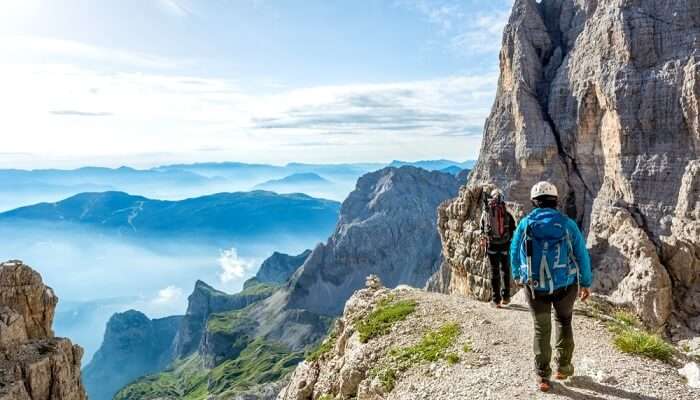
Bolivia has seven peaks in the Royal Range that are above 6,000 meters and over 600 peaks which are above 5,000 meters. There is a lot to explore when it comes to Bolivian mountaineering expeditions. Bolivia offers its climbers the best climbing opportunity with some finest routes. Bolivia is also home to some of the best and most easily accessible routes and has one of the most stable weather when considering other mountaineering options across the world. The rawness of Bolivia keeps it for the adventure loving people who are not looking for ultimate comfort and ready to get dirty in the soil. Here is mountaineering in Bolivia guide for all those who crave thrill and adventure!
Best Time For Mountaineering In Bolivia
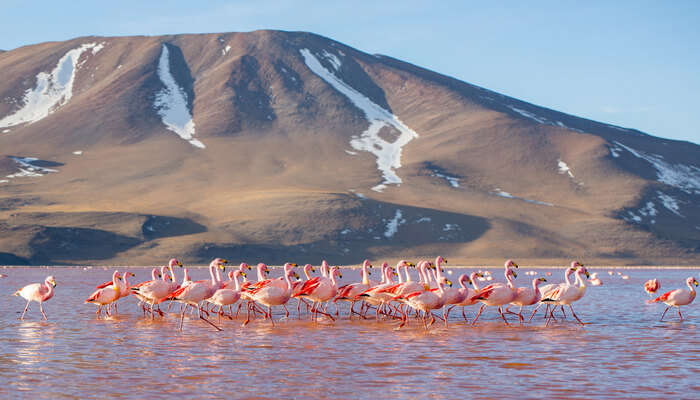
Bolivia has one climbing season that starts in May and remains until September. June is the best month when considering weather for the climbers. After June some of the routes become icy which makes it difficult to climb and thus are physically more demanding. However planned tours are available till mid-August. One must check the weather forecast before you head for any kind of expedition whatever month you are going for it.
Must Read: 10 Brazilian Desserts To Satiate Your Taste Buds In This South American Wonderland
8 Spots For Mountaineering In Bolivia
Here is a list of famous sites for mountaineering in Bolivia that you ought to visit on your vacation. Keep scrolling down and read along to know more about them!
1. Illampu
2. Chachacomani South Route
3. Charquini
4. Pequeno Alpamayo
5. Huayna Potosi
6. Sajama
7. Illimani
8. Chachacomani South West Face
1. Illampu
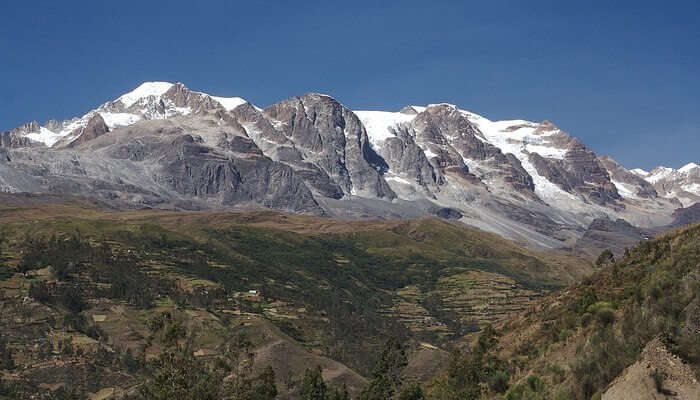
Illampu is one of the most demanding climbs in the Cordillera Real. You not only require to be fit physically, but also require having technical skills of climbing. This range sits at an altitude of 6,342 meters and takes around 6 days to complete. The expedition is for only people, who are in very good shape and holds a good amount of experience in climbing. But it all pays off in the end when you get to experience the spectacular climbs and Bolivian Mountains.
Location: La Paz Department, Larecaja Province, Guanay Municipality, southeast of Chearoco
How To Reach: One can reach the campsite easily using train and bus to Sorata and then walk your way to Illampu.
Suggested Read: 10 Best Places To Visit In Chile Which Are You Ready To Give You A Glimpse Of South America!
Looking To Book An International Holiday?
2. Chachacomani South Route
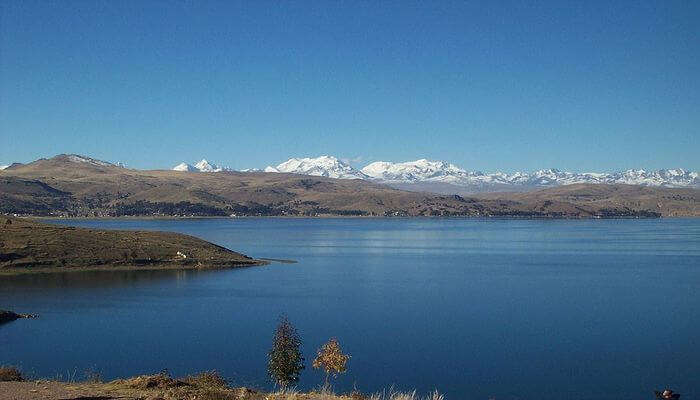
Chachacomani South Route stands at an altitude of 6100 meters and takes around six days to complete. This is one of the least visited peaks of the Cordillera Real and is a perfect expedition for people who love ice climbing. This is a perfectly unique climbing experience that will give you climbing challenges that you would have rarely experienced.
Location: La Paz Department, Larecaja Province, Guanay Municipality, southeast of Chearoco
How To Reach: No public transport is available in this area. You need to hire a jeep from La Paz and travel via Penas to Hichukhota valley.
Suggested Read: Brazil Wildlife: A Mini Guide To Explore The Enchanting Carnival Land Of South America!
3. Charquini

Charquini is at an altitude of 5400 meters and takes around two days to complete. It is an intermediate level climbing and is an ideal expedition for people who wish to climb Bolivian mountains, but don’t have any prior experience of climbing. This is also an alternative for ski squads when Chacaltaya snow disappears.
Location: Huyana Potosi Massif
How To Reach: Reach La Paz and arrange a means of transport to Laguna Zongo.
Suggested Read: 7 Places To Visit In Paraguay To Spruce Up Your South American Holiday
4. Pequeno Alpamayo
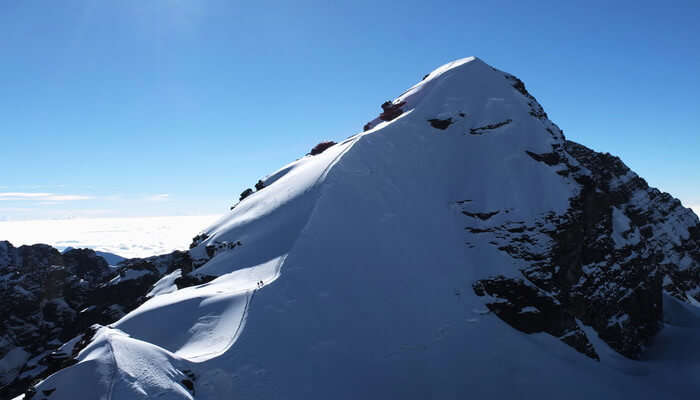
Pequeno Alpamayo is at an altitude of 5300 meters and takes three days to complete. It is again an intermediate level trek with very good acclimatization. This would be an ideal practice route for people who would like to climb higher peaks in another area. It is kind of an introduction for people who have little or no experience of climbing before.
Location: Condoriri Group in La Cordillera Blanca in Bolivia
How To Reach: Reach La Paz and from there reach the Tuni area and later hire transport to reach the campsite next to Chiar Khota.
Suggested Read: 10 Best Things To Do In Brazil For A Wild & Unforgettable South American Sojourn
5. Huayna Potosi

Huayna Potosi is at an altitude of 6000 meters and takes around three days to complete. You get to practice in ice before you take up mountain climbing. It is a better experience than a two-day expedition with a lot more options to enjoy greater climbs and better chances of making up than a 2-day expedition. This mountain also has a tale associated with it that it is the first son of king and queen mountains – The Illampu and Illimani.
Location: Near El Alto
How To Reach: From airport hire a taxi to downtown to La Paz. From La Paz, public transport is available for Zongo where all the eastern routes originate.
Suggested Read: Top 15 Places To Visit In Ecuador For A Megadiverse Tour In South America
Planning your holiday but confused about where to go? These travel stories help you find your best trip ever!
6. Sajama

Sajama is at an altitude of 6500 meters and takes four days to complete. It comes under a difficult category and requires you to have prior experience of ice climbing. This is one of the highest mountains in Bolivia and stands apart from the rest of the ranges. It is a beautiful climb. The mountain is also a dormant volcano that has a perfect conical shape.
Location: Oruro Department, Bolivia
How To Reach: There are no direct buses to Sajama, you must travel to a small town Patacamaya and walk your way through. The buses are available from La Paz and Oruro.
Suggested Read: This Island In South America Is The World’s Most Dangerous Place
7. Illimani
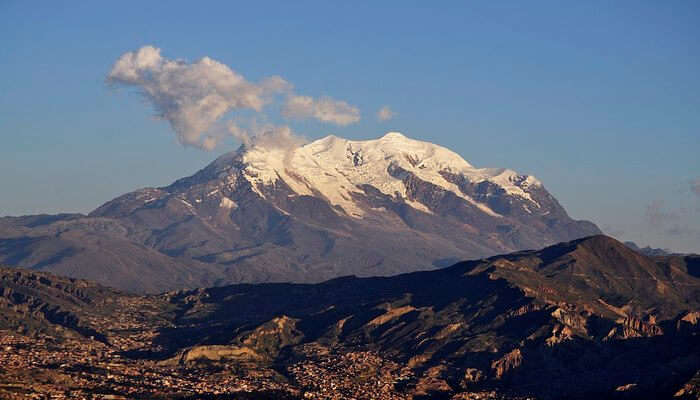
Illimani is at an altitude of 6400 meters and is four days of the difficult climbing expedition. The mountain is on the south end of La Paz and is a famous mountain amongst locales and it is the Queen of the Royal Ranges in Bolivia. This climb is not only physically demanding but is also hard to climb in technical terms. The whole climb comes at an average gradient of 50 degrees, which is stressful if you don’t have prior experience of climbing.
Location: Near the cities of El Alto and La Paz at the eastern edge of the Altiplano
How To Reach: You can reach Illimani from La Paz. There are two basic routes to the west side, via Pinaya and Cohonu.
Suggested Read: Follow These International Travel Tips For An Epic Overseas Holiday!
8. Chachacomani South West Face
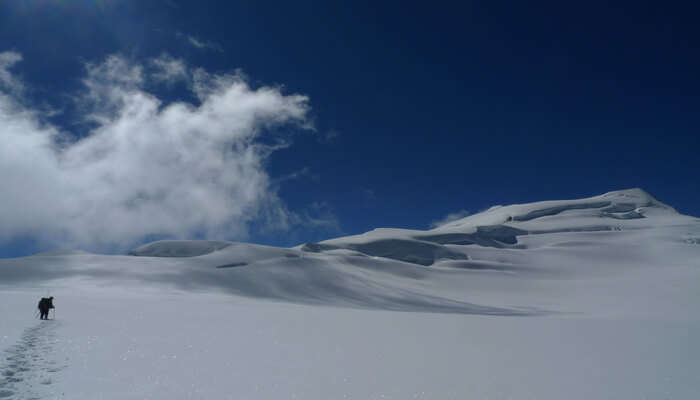
Chachacomani South West Face is at an altitude of 6100 meters and is four days of a difficult climb. It’s a new route recently explored on Chachacomani. It is a challenging route. Another advantage of this expedition is that it is shorter and as it lies on the west side of the range provides more common ascent of the peak. It has a lot of valleys on the route and is an honor for any climber to be able to complete this climb successfully.
Location: Cordillera Real of the Andes Mountains
How To Reach: No public transport is available in this area. You need to hire a jeep from La Paz and travel via Penas to Hichukhota valley.
Suggested Read: 32 Budget International Trips For Your Holiday Which Will Cost You Less Than An iPhone!
Tips

- Plan and prepare to ascend. This will help you extend yourself while you are on your expedition and you will be able to enjoy it as well.
- Invest in good mountaineering footwear.
- Carry enough food in case your trek partner is not providing it. You will require a lot of it.
- Check the local weather forecast before you head towards your mountaineering expedition.
- Carry emergency shelters to deal with any kind of exigency or weather surprises you might get on your way.
- Think of any kind of hazard that could occur while you are climbing and have a plan ready to deal with it in advance so that you know what needs to be done when it occurs.
Suggested Read: Discover & Relish These Best International New Years Destinations On Budget
What To Pack?

- A pair of trousers or track pants, leggings, shorts, One warm sweater, One rain jacket, Short sleeved tops and 4 pair of socks
- One pair of flip flops and one pair of sneakers
- Sunglasses, Microfiber Towel, Pair of gloves and scarf, Hat and Umbrella, Sunscreen and Sanitary Products
- Band-Aids and medicines like pain killers, altitude sickness medicine and Imodium
- Passport, Travel Insurance, Local Currency, ID Card and plane tickets and proof of Onward Travel
Permission For Mountaineering In Bolivia
You generally do not require a visa for less than a three-month expedition to Bolivia however you must check this with your trekking partner. Also, one need to get vaccinated before you reach Bolivia. Other than this since the mountains are quite high and provide dangerous paths, you need to have a trekking partner. Your trek partner will help you with all kinds of permits and permissions required while you mountaineer expedition in Bolivia.
Further Read: 9 Places To Visit In Bolivia That Depict The True Beauty Of South America!
Mountaineering In Bolivia is challenging but in a good way. The place is home to various trek partners who are humble and quite experienced. They tend to make your climb easy and smooth. You can get all sorts of mountaineering adventure here right from high altitudes for your mountaineering climbing and trekking expeditions. The country island of endless culture and natural attractions and gives you cool crisp air to breathe and pollution free environment to enjoy and admire. You can enroll for various climbs available right from a beginner’s level to a pro-level. So, plan your international vacation right away and get ready to channelize the inner adventure junkie in you in Bolivia!
Disclaimer: TravelTriangle claims no credit for images featured on our blog site unless otherwise noted. All visual content is copyrighted to its respectful owners. We try to link back to original sources whenever possible. If you own the rights to any of the images, and do not wish them to appear on TravelTriangle, please contact us and they will be promptly removed. We believe in providing proper attribution to the original author, artist or photographer.
Please Note: Any information published by TravelTriangle in any form of content is not intended to be a substitute for any kind of medical advice, and one must not take any action before consulting a professional medical expert of their own choice.
Frequently Asked Questions About Mountaineering In Bolivia
What kind of bathing options are available while on the Bolivia Mountaineering expedition?
Showers are only available in your hotel that your board before and after your climb. One must carry wet wipes for impromptu washes as merely any shower options will be available.
What eating options will be available during our climb?
Ample eating options will be available with your guide. You will get all three meals and as many hot and cold drink options.
What kind of lodges and hotels are available while en route?
Your trip organizer will arrange lodges and hotels for you, so it all depends on your travel itinerary. Please check the ratings before you book one.
What is the best equipment for photography in Alpine environments?
Some of the best pictures are taken while you are in the mountains, however, one must keep a simple and light camera with them. The most recommended options are iPhones and GoPros. However, all cameras have maintenance issues at high altitudes.
What are the physical parameters required for the climb?
One should be comfortable walking around 6 to 8 hours with a weighted pack for any climb in Bolivia. For certain climbs, you also need to have prior climbing experience and some technical know-how. They will ask you to join the training batch before they take you to these expeditions.
How do I judge what is my level?
Talk to your trek organizer and they will suggest you which trek you will be able to complete and enjoy. And one must not deny what they suggest, because they know the route and have prior experience.
What about insurance for our trek?
This should be part of your trek package. However, you must check this part with your travel partner and get it if in case it’s not included.
Do we require to arrive a day before our trip starts?
Most of the trek organizers will tell you the assembling time and you must book your flights accordingly. Some even require you to join a boot camp to get you ready for a difficult climb.
Looking To Book A Holiday Package?

Exploring new places and trying out new food cuisines are two things that bring Seema all the happiness. Travel freak and a die-hard foodie are the synonyms that define her the best. Popular on social media by the name of ‘PandaReviewz’, lazing around the beaches, exploiting the sunset points, visiting the farthermost villages, exploring the renowned cities, trying out new food cuisines, and blogging about them are few things that keep Seema occupied, and happy!







































